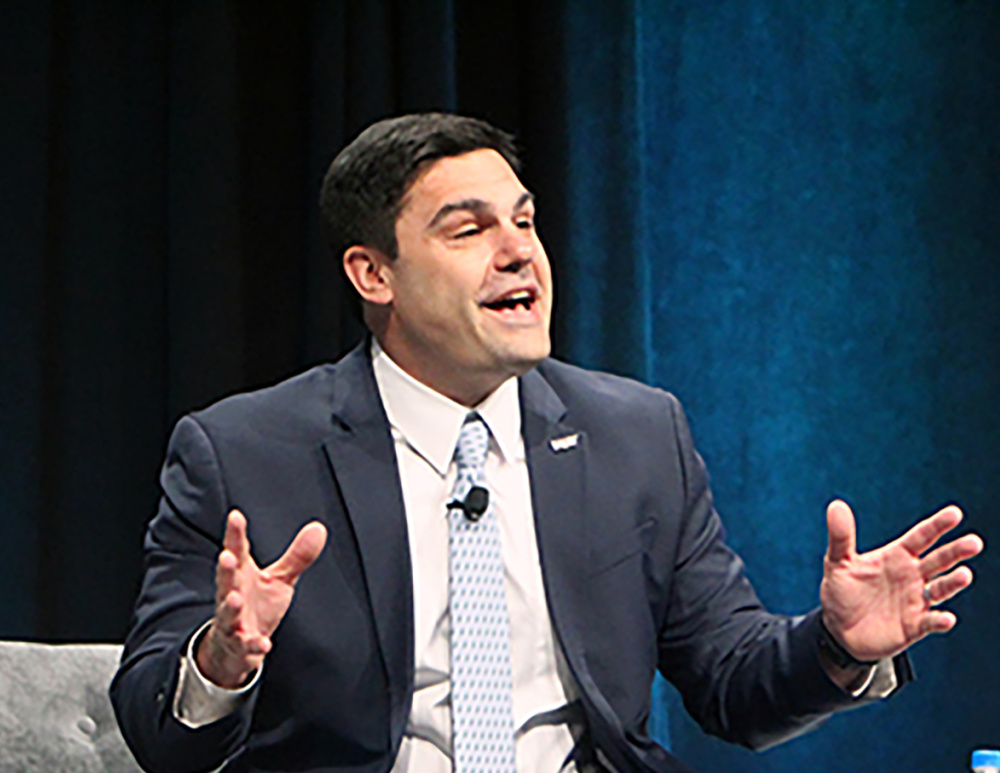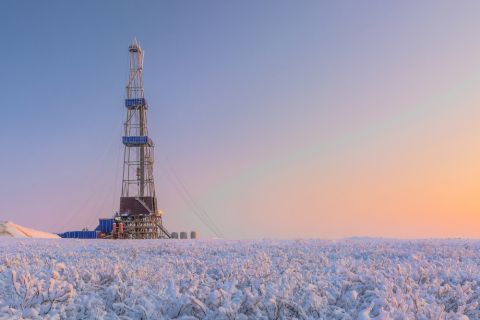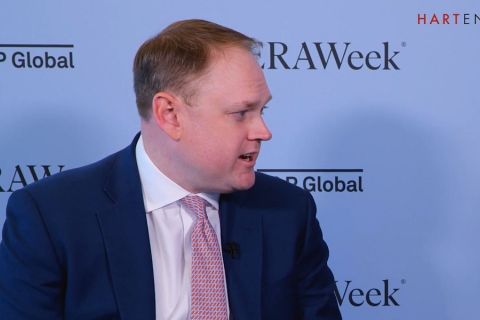Presented by:
He’s been called “Fossil Fuels’ Forthright Defender” by The Wall Street Journal. He’s been on countless morning news programs. He’s appeared at a plethora of events. In each case, Toby Rice, CEO of EQT Corp., has the same message for anyone who is listening: It’s necessary for the U.S. to “unleash LNG” to help decarbonizing efforts in the energy sector and to provide energy security for the nation, and the world, particularly in the wake of Russia’s aggression in Ukraine.
The message may be starting to get through. Recent statements and actions from the White House and the Department of Energy indicate a recognition—even if begrudgingly—to produce more LNG for export. But is it enough? Can more gas actually be produced and exported given the dearth of infrastructure and LNG facilities, particularly in the northeast?
 In advance of this summer’s DUG East Conference & Exhibition in Pittsburgh, Rice continued an ongoing conversation with Hart Energy about the rapidly changing nature of natural gas production, infrastructure buildout, messaging and decarbonization success.
In advance of this summer’s DUG East Conference & Exhibition in Pittsburgh, Rice continued an ongoing conversation with Hart Energy about the rapidly changing nature of natural gas production, infrastructure buildout, messaging and decarbonization success.
Len Vermillion: Let’s start by talking about the idea of “unleashing” U.S. LNG exports. Can you put it in perspective for us?
Toby Rice: Let’s talk about the reaction we’ve received to date. It’s been absolutely tremendous. The reason why there’s been a lot of support, I think, is because the “unleash” plan is targeted. It’s addressing the biggest issue: emissions [from] foreign coal. It's incredibly impactful. There’s nothing bigger.
It’s feasible. Adding 50 rigs, something like that is really achievable for this industry to do. So, we’re getting a lot of support, but there will be people that may oppose this plan. People that would oppose it would be those who have a “keep it in the ground” mentality and really will only support zero-carbon energy solutions like solar and wind. Now, we need to have people evolve their mentality from zero-carbon-only solutions to any decarbonizing solution. That’s what we want to get to.
It’s extremely encouraging to see people like John Kerry actually say natural gas is decarbonizing.
LV: Wow! Yes.
TR: Tremendous. Now to see the administration support LNG exports, to see the energy secretary say, “Hey, we’ve approved some permits”—that’s normal course to business, getting FERC permits approved. But the fact that they’re trying to take credit for it is a sign that they think it’s good, and they want to be associated with it. So, the mentality is starting to change.
The desire to want to get credit and be associated with it is there, but the ultimate show of support is only going to be realized once we start putting really large-scale projects on the table.
These projects are going to be where we can say, “These are the facilities we need. These are the pipelines we need to get it there. These are the policies we need to fast track permitting. And these are the people that support it.
The industry right now is in the process of putting more of those projects on the table. So, in the next year, I think we'll have the opportunity to get a really firm understanding on who's supportive, and that will be a good sign going forward.
U.S. NATURAL GAS
Already the global leader, what’s the growth potential for U.S. natgas?
Join as world class leaders discuss projections for U.S. gas plays at the America’s Natural Gas Conference on September 27 in Houston.
Learn MoreLV: Obviously, you’re in the Marcellus and there’s a lot of resource there to help out. How much are we talking about, and how can we make that move faster beyond approvals? What else needs to happen?
TR: Well, No. 1, political signals that there is going to be support here, that the infrastructure that we need to build will not go through [the] process that happened to [Mountain Valley Pipeline].
With those projects slated, we can start working backward.
We need to get the LNG facilities, get the pipelines [and then] get the pipelines connected to those facilities. That needs to happen first. I think once you see those long poles in the tent go up, the upstream side of things ... I mean, we’re going to be able to fill the production. But the point is it’s going to be sustainable growth. It’s going to be a growth with confidence that we get these facilities built.
One thing that’s worth people understanding in an unleashed U.S. LNG scenario the potential that we could provide the world is an increase in 50 Bcf [billion cubic feet] a day of LNG exports. How do we get to that number? Why is it 50, not 20 or a hundred? We looked at the resource around the country and said, “How much can we grow that production under the constraint that you can only grow to a point that you can hold flat for 30 years?” With that constraint on the growth, the number translates that we have the resource to be able to support an increase to 50 Bcf a day above where we’re at today. Where is that coming from? It’s about 15 Bcf a day incrementally coming from the Gulf Coast, Haynesville, and 35 Bcf a day is coming from Appalachia.
So, when you think about where do the pipelines need to be, where does the LNG infrastructure need to be? It needs to be close to the supply. The most efficient thing we can do is construct LNG facilities in the northeast or the pipelines associated with the production.
LV: What happens if we can’t get this going? What’s the risk here? Obviously not only for the industry but for the world. If we can’t get these LNG facilities built, we really don’t have a way to get this resource out, do we?
TR: If we’re not successful in building these LNG facilities and associated pipelines, then the world will continue to be undersupplied with energy. The world will still be faced with major energy security issues. Russia will still have its influence. The emissions around the world will continue to rise because of the use of foreign coal, and on top of it, 3 billion people around the world will still be left short, living on less electricity that takes to run a refrigerator.
“If we’re not successful in building these LNG facilities and associated pipelines, then the world will continue to be undersupplied with energy. The world will still be faced with major energy security issues. Russia will still have its influence.”
LV: What can the industry do to speed this process up? How does it get this message out?
TR: I think it’s developing projects. That’s No. 1. Also, working in the meantime at developing our reputations. There are environmental concerns that come along with the actual production of U.S. natural gas, namely methane emissions, [which] is a big issue right now. We need to address that. We need to bulletproof our operations. We need to resolve these methane emissions in our operations. The good news is we know exactly where these emissions are coming from. We know the piece of equipment that we can use to replace the source, the leaking emissions. For natural gas players, that is pneumatic devices. We can replace all of those. EQT is going to replace over 9,000 of these devices, and we’ll be done with that by the end of the next 24 months. And there’s a million of these devices installed around the country. Operators need to continue to work to replace their pneumatic devices with low-bleed or zero-bleed methane emission devices. That’s one thing that's going to make our operations cleaner.
The other thing we need to do is we need to certify these results. This is what we say, we need to bring in the third-party environmental accountants to come in and verify the great work that we’re doing right now. That can be encapsulated by getting our natural gas RSG [responsibly sourced gas] certified.
There’s a number of frameworks that are out there, and we’re incredibly excited to see the industry is already moving in this direction with the record amount of RSG adoption across the board. It’s extremely encouraging to see. All of these things mean that we will be successful in showcasing that American energy is the cleanest energy in the world, and as long as we’re using hydrocarbons in this world, we should be sourcing that from the United States.
LV: I saw in one of your TV interviews that you talked about infrastructure and how the lack of buildout isn’t just about hydrocarbons; it affects electricity, it affects hydrogen, everything. Is there a way that helps get a message out? That it’s not just about building out for the natural gas industry.
TR: I think Americans need to understand that we are facing energy insecurity. We are seeing energy insecurity here domestically today. Energy insecurity in general starts showing up as high energy prices. Well, guess what? Look around the country; we’ve got unnecessarily high energy prices. And when you have that, then you start seeing the economy start to get challenged, [that] shuts down, inflation runs rampant. Guess what? We have that here, too.
So, while I don’t feel like we’ll ever get to a place where we’ll be engaging in the third and final phase, which is military conflict, we see enough of the warning signs here today. We should act now and think about ways that we can unleash American energy to create more supply and get back the energy security that Americans deserve and [that] we are fully capable of achieving, but we need the pipeline infrastructure and LNG facilities to create, not disrupt, the supply-demand fundamentals. That is absolutely incredibly important in the sustainable shale era that we’re working in today.
LV: You mentioned before about John Kerry. I know you’ve been saying natural gas is the biggest greenhouse gas initiative out there, so maybe the message is getting through to people? How is it the biggest greenhouse gas initiative that we’re facing right now?
TR: It’s really simple. The biggest source of emissions on the planet comes from foreign coal. Almost 50% of emissions around the world come from foreign coal. Fortunately, there’s a solution to lower those emissions and replace that foreign coal, and that is U.S. natural gas and the forum of LNG.
Now, what’s really amazing is when you replace coal with natural gas, a Bcf a day’s worth of coal or a Bcf a day of natural gas will lower emissions by about 30 million tons per year. When we talk about increasing our LNG export capacity by 50 Bcf a day, we’re talking about lowering emissions by 1.5 billion tons per year. That is the environmental equivalent of electrifying every vehicle in the United States, putting solar panels in every home and doubling the U.S. wind capacity combined. It’s absolutely massive.
By the way, this isn’t a new trick. This is exactly what we’ve done here in the United States to be the world leader in lowering emissions, replacing our domestic coal with natural gas. We’ve done an amazing job there, but now we have the opportunity to replicate the success on a world stage. This is the only way that the U.S. can influence on a world stage, by leveraging our low-carbon resources to replace and retire high-carbon resources like foreign coal.
“We need to bulletproof our operations. We need to resolve these methane emissions in our operations.”

LV: You’re one of the companies who have committed to net-zero initiatives and offsets. Do people really understand how offsets work? Can you explain what that really does to advance the idea that the industry is decarbonizing?
TR: When it comes to emissions, there are three different scopes that are out there— Scope 1, 2 and 3. Scope 1 and 2 are the emissions that are associated with our operations and what it takes for us to create our product. We understand what our carbon footprint is, and there's things that we can do organically to reduce that. At EQT, we will be reducing our greenhouse-gas emissions to run our business by over 65%. A big part of it is going to come from eliminating our methane emissions. But at the end of the day, we will still have a carbon footprint because it takes energy to run our rigs, run our frac crews, and those will create CO2 emissions from burning diesel and natural gas … So, we are always going to have a carbon footprint in this industry, but the good news is we can offset that carbon footprint by developing carbon offsets, and carbon offsets are basically creating carbon sinks in the world.
There’s a number of different ways we can do it, whether they’re land-based, like planting trees or encouraging no-till agriculture or doing things subsurface and injecting CO2 underground. All these things are ways that we can pull carbon out of the atmosphere and use that to create a net-zero carbon footprint for our businesses to create our product.
Now, Scope 3 is a different scenario. Scope 3 is what the emissions are when people use our product. And this is something that’s incredibly important. Now we look at our product and we’re saying we want to grow our production of natural gas because we know that putting more natural gas in the world is going to lower coal, and every Bcf a day we put into this world is going to eliminate 30 million tons of emission. At EQT, the gross gas that we produce is actually saving the world over 180 million tons of CO2 emissions per year. So, we’re totally fine having a focus beyond net zero for Scope 1 and 2, but for Scope 3, I think we need to take a holistic approach, and what is our product used for and what emissions does it abate. And natural gas is a really amazing story to tell on that front.
LV: Are there factors outside of regulations and infrastructure such as market factors or demand outlooks that actually inhibit us from building a production? Obviously, you want to keep it steady, but is there anything else in the way of us really pulling the resource out, delivering it?
TR: No, we just need a demand signal. That demand signal is very clear. Those bombs dropping in Ukraine, that was a demand signal to replace Russia’s ability to export energy. The world calling for cleaner energy and concerns that people have around the world about emissions, that is a demand signal for natural gas. Russia alone is exporting 20 Bcf a day of U.S. LNG demand that we should be filling.
And something that I’m incredibly excited about: Obviously, there’s been acceleration in the demand grab from international buyers because of Russia but also from an environmental front, there’s also been a greater desire to decarbonize because we continue as a world to increase our emissions year-over-year.
Every year that we fail to make progress, every year that we fail to unleash U.S. LNG, is another year that the urgency to move quickly just gets greater and greater. The good news is this is something that we can start working on right now and continue on the great work that we've already done by establishing ourselves as the world leader in LNG exports, but we can do a whole lot more.
LV: You’re getting known as a defender of the industry. Why is that important to you beyond just the fact that you're leading the biggest natural gas producer? Why are you being so vocal about the need for LNG and natural gas to be used?
TR: Yeah, because I want to make an impact on the world. When we sold Rice Energy, we had the opportunity to step back, think about what we’re going to do next in life. For me, I wanted to make an impact. There’s a bunch of ways to do it. But the thing that stood to me was the biggest correlation in driving the quality of life is the correlation between energy use and quality of life. Simply put, the more energy people use, the better the quality of life. And if you can bring the world cheaper, reliable, clean energy, the quality of life around the world will skyrocket.
There’s more than 3 billion people in this world that are living in energy poverty. There’s billions more people around the world struggling with their energy bills right now. We can address those by putting more energy in the world. But one of the things as of late in the last five years that has prevented us from putting more energy into the world is people’s concerns over climate. And what we wanted to do is take a holistic approach on energy transition and say, “What is the most practical, pragmatic way to address climate and meet the emissions targets of the world?” And that answer was very clear. Let’s attack the biggest source of emissions on the planet, foreign coal, and let’s leverage our resources, U.S. LNG, to be the vehicle that can replace that energy.
So that’s why we’re doing this. It’s incredibly good for the world, but our higher purpose at the end of the day is providing energy security to the world. While arresting climate change, we need to make climate-centric arguments on why we should be able to continue to do the great work that we do.
Recommended Reading
US EPA Expected to Drop Hydrogen from Power Plant Rule, Sources Say
2024-04-22 - The move reflects skepticism within the U.S. government that the technology will develop quickly enough to become a significant tool to decarbonize the electricity industry.
Biden Administration Criticized for Limits to Arctic Oil, Gas Drilling
2024-04-19 - The Bureau of Land Management is limiting new oil and gas leasing in the Arctic and also shut down a road proposal for industrial mining purposes.
Exclusive: The Politics, Realities and Benefits of Natural Gas
2024-04-19 - Replacing just 5% of coal-fired power plants with U.S. LNG — even at average methane and greenhouse-gas emissions intensity — could reduce energy sector emissions by 30% globally, says Chris Treanor, PAGE Coalition executive director.
Renewed US Sanctions to Complicate Venezuelan Oil Sales, Not Stop Them
2024-04-19 - Venezuela’s oil exports to world markets will not stop, despite reimposed sanctions by Washington, and will likely continue to flow with the help of Iran—as well as China and Russia.




